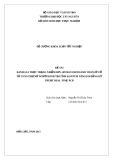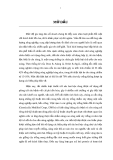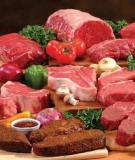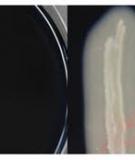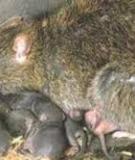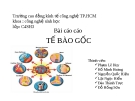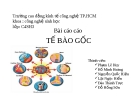BioMed Central
Genetics Selection Evolution
Open Access
Research Comparison of classification methods for detecting associations between SNPs and chick mortality Nanye Long*1, Daniel Gianola1,2, Guilherme JM Rosa2, Kent A Weigel2 and Santiago Avendaño3
Address: 1Department of Animal Sciences, University of Wisconsin, Madison, WI 53706, USA, 2Department of Dairy Science, University of Wisconsin, Madison, WI 53706, USA and 3Aviagen Ltd., Newbridge, Midlothian, EH28 8SZ, UK
Email: Nanye Long* - nlong@wisc.edu; Daniel Gianola - gianola@ansci.wisc.edu; Guilherme JM Rosa - grosa@wisc.edu; Kent A Weigel - kweigel@wisc.edu; Santiago Avendaño - savendano@aviagen.com * Corresponding author
Published: 23 January 2009
Received: 17 December 2008 Accepted: 23 January 2009
Genetics Selection Evolution 2009, 41:18
doi:10.1186/1297-9686-41-18
This article is available from: http://www.gsejournal.org/content/41/1/18
© 2009 Long et al; licensee BioMed Central Ltd. This is an Open Access article distributed under the terms of the Creative Commons Attribution License (http://creativecommons.org/licenses/by/2.0), which permits unrestricted use, distribution, and reproduction in any medium, provided the original work is properly cited.
Abstract Multi-category classification methods were used to detect SNP-mortality associations in broilers. The objective was to select a subset of whole genome SNPs associated with chick mortality. This was done by categorizing mortality rates and using a filter-wrapper feature selection procedure in each of the classification methods evaluated. Different numbers of categories (2, 3, 4, 5 and 10) and three classification algorithms (naïve Bayes classifiers, Bayesian networks and neural networks) were compared, using early and late chick mortality rates in low and high hygiene environments. Evaluation of SNPs selected by each classification method was done by predicted residual sum of squares and a significance test-related metric. A naïve Bayes classifier, coupled with discretization into two or three categories generated the SNP subset with greatest predictive ability. Further, an alternative categorization scheme, which used only two extreme portions of the empirical distribution of mortality rates, was considered. This scheme selected SNPs with greater predictive ability than those chosen by the methods described previously. Use of extreme samples seems to enhance the ability of feature selection procedures to select influential SNPs in genetic association studies.
times explain less than 1% of the phenotypic variation [3].
Introduction In genetic association studies of complex traits, assessing many loci jointly may be more informative than testing associations at individual markers. Firstly, the complexity of biological processes underlying a complex trait makes it probable that many loci residing on different chromo- somes are involved [1,2]. Secondly, carrying out thou- sands of dependent single marker tests tends to produce many false positives. Even when significance thresholds are stringent, "significant" markers that are detected some-
Standard regression models have problems when fitting effects of a much larger number of SNPs (and, possibly, their interactions) than the number of observations avail- able. To address this difficulty, a reasonable solution could be pre-selection of a small number of SNPs, fol- lowed by modeling of associations between these SNPs and the phenotype [4]. Other strategies include stepwise
Page 1 of 14 (page number not for citation purposes)
Genetics Selection Evolution 2009, 41:18
http://www.gsejournal.org/content/41/1/18
detailed description of these SNPs is given in Long et al. [13].
selection [5], Bayesian shrinkage methods [6], and semi- parametric procedures, such as mixed models with kernel regressions [7,8].
Machine learning methods are alternatives to traditional statistical approaches. Machine learning is a branch of artificial intelligence that "learns" from past examples, and then uses the learned rules to classify new data [9]. Their typical use is in a classification framework, e.g., dis- ease classification. For example, Sebastiani et al. [10] applied Bayesian networks to predict strokes using SNP information, as well as to uncover complex relationships between diseases and genetic variants. Typically, classifi- cation is into two classes, such as "unaffected" and "affected". Multi-category classification has been studied, for example, by Khan et al. [11] and Li et al. [12]. It is more difficult than binary assignment, and classification accu- racy drops as the number of categories increases. For instance, the error rate of random classification is 50% and 90% when 2 and 10 categories are used, respectively.
The entire data set was divided into four strata, each rep- resenting an age-hygiene environment combination. For example, records of early mortality status of birds raised in low hygiene conditions formed one stratum, denoted as EL (early age-low hygiene). Similarly, the other three strata were EH (early age-high hygiene), LL (late age-low hygiene) and LH (late age-high hygiene). Adjusted sire mortality means were constructed by fitting a generalized linear mixed model (with fixed effect of dam's age and random effect of hatch) to data (dead or alive) from indi- vidual birds, to get a residual for each bird, and then aver- aging progeny residuals for each sire (see Appendix). After removing SNPs with missing values, the numbers of sires and SNPs genotyped per sire were: EL and LL: 222 sires and 5,119 SNPs; EH and LH: 232 sires and 5,166 SNPs. Means and standard deviations (in parentheses) of adjusted sire means were 0.0021 (0.051), -0.00021 (0.033), -0.0058 (0.058) and 0.00027 (0.049) for EL, EH, LL and LH, respectively. Subsequently, SNP selection and evaluation were carried out in each of the four strata in the same way.
Categorization of adjusted sire mortality means Sire mortality means were categorized into K classes (K = 2, 3, 4, 5 or 10). The adjusted sire means were ordered, and each was assigned to one of K equal-sized classes in order to keep a balance between sizes of training samples falling into each category. For example, with K = 3, the thresholds determining categories were the 1/3 and 2/3 quantiles of the empirical distribution of sire means. This is just one of the many possible forms of categorization, and it does not make assumptions about the form of the distribution.
In a previous study of SNP-mortality association in broil- ers [13], the problem was cast as a case-control binary classification by assigning sires in the upper and lower tails of the empirical mortality rate distribution, into high or low mortality classes. Arguably, there was a loss of information about the distribution, because intermediate sires were not used. In the present work, SNP-mortality associations were studied as a multi-category classifica- tion problem, followed by a filter-wrapper SNP selection procedure [13] and SNP evaluations. All sire family mor- tality rates were classified into specific categories based on their phenotypes, and the number of categories was varied (2, 3, 4, 5 or 10). The objectives were: 1) to choose an inte- grated SNP selection technique by comparing three classi- fication algorithms, naïve Bayes classifier (NB), Bayesian network (BN) and neural network (NN), with different numbers of categories, and 2) to ascertain the most appro- priate use of the sire samples available.
"Filter-wrapper" SNP selection A two-step feature selection method, "filter-wrapper", described in Long et al. [13] was used. There, upper and lower tails of the distribution of sire means were used as case-control samples, and the classification algorithm used in the wrapper step was naïve Bayes. In the present study, all sires were used in a multi-category classification problem, and three classification algorithms (NB, BN and NN) were compared.
"Filter" step A collection of 50 "informative" SNPs was chosen in this step. It was based on information gain [9], a measure of how strongly a SNP is associated with the category distinc- tion of sire mortality means. Briefly, information gain is the difference between entropy of the mortality rate distri- bution before and after observing the genotype at a given SNP locus. The larger the information gain, the more the
Methods Data Genotypes and phenotypes came from the Genomics Ini- tiative Project at Aviagen Ltd. (Newbridge, Scotland, UK). Phenotypes consisted of early (0–14d) and late (14–42d) age mortality status (dead or alive) of 333,483 chicks. Birds were raised in either high (H) or low (L) hygiene conditions: 251,539 birds in the H environment and 81,944 in the L environment. The H and L environments were representative of those in selection nucleus and com- mercial levels, respectively, in broiler breeding. Informa- tion included sire, dam, dam's age, hatch and sex of each bird. There were 5,523 SNPs genotyped on 253 sires. Each SNP was bi-allelic (e.g., "A" or "G" alleles) and genotypes were arbitrarily coded as 0 (AA), 1 (AG) or 2 (GG). A
Page 2 of 14 (page number not for citation purposes)
Genetics Selection Evolution 2009, 41:18
http://www.gsejournal.org/content/41/1/18
SNP reduces uncertainty about mortality rate. As noted earlier, the 50 top scoring SNPs with respect to their infor- mation gain were retained for further optimization in the wrapper step. The filter procedure was coded in Java.
small (Appendix). Hence, FS was adopted for BN. For NB and NN the search method was BE. The wrapper proce- dure was carried out on the Weka platform [16]. Comput- ing time for running wrapper using the search method selected for each of NB, BN and NN was 1 min for NB, 3 min for BN and 8.2 h for NN. These were benchmarked on a dataset with 222 sires and 50 SNPs, which was typical for each stratum.
Naïve Bayes Let (X1,..., Xp) be features (SNPs) with discrete values (e.g., AA, AG or GG at a locus) used to predict class C ("low" or "high" mortality). A schematic is in Figure 1. Given a sire with genotype (x1,..., xp), the best prediction of the mortal- ity class to which it belongs is that given by class c which maximizes Pr(C = c | X1 = x1,..., Xp = xp). By Bayes' theorem,
=
Pr(
) Pr(
)
X
= C c
1
=
=
=
=
Pr(
|
,
,
)
.
C c X
x
X
x
1
1
p
p
)
x 1 Pr( X
= = | , , X p xp C c X p xp= = ,, , x 1
1
"Wrapper" step This procedure is an iterative search-and-evaluate process, using a specific classification algorithm to evaluate a sub- set of SNPs (relative to the full set of 50 SNPs) searched [14]. Three classification algorithms, NB, BN and NN, were compared in terms of the cross-validation classifica- tion accuracy of the chosen subset of SNPs. Two widely used search methods are forward selection (FS) and back- ward elimination (BE) [15]. FS starts from an empty set and progressively adds SNPs one at time; BE starts with the full set, and removes SNPs one at a time. The search methods stop when there is no further improvement in classification accuracy. In general, BE produces larger SNP sets and better classification accuracy than FS [13,16], but it is more time-consuming. Differences in computation time between BE and FS were large when the classification algorithm was BN, which was computationally intensive. However, the difference between FS and BE in terms of classification accuracies of the chosen SNP subsets was
Pr(C = c) can be estimated from training data and Pr(X1 = x1,..., Xp = xp) is irrelevant for class allocation; the predicted value is the class that maximizes Pr(X1 = x1,..., Xp = xp | C = c). NB assumes that X1,..., Xp are conditionally independ-
Illustration of naïve Bayes (NB) Figure 1 Illustration of naïve Bayes (NB). X1,..., Xp are SNPs used to predict class C (e.g., "low" or "high" mortality). NB assumes SNP independence given C.
Page 3 of 14 (page number not for citation purposes)
Genetics Selection Evolution 2009, 41:18
http://www.gsejournal.org/content/41/1/18
z
where
= ∑
; xj is SNPj and wjh is the weight
h
w x jh j
j
ent given C, so that Pr(X1 = x1,..., Xp = xp | C = c) can be decomposed as Pr(X1 = x1 | C = c) × (cid:2) × Pr(Xp = xp | C = c). Although the strong assumption of feature independence given class is often violated, NB often exhibits good per- formance when applied to data sets from various domains, including those with dependent features [17,18]. The probabilities, e.g., Pr(X1 = x1 | C = c), are esti- mated using the ratio between the number of sires with genotype x1 that are in class c, and the total number of sires in class c.
applied to connection from SNPj to hidden node h (h = 1, 2). Similarly, a node in the output layer takes a weighted sum of all hidden nodes and, again, applies an activation function, and takes its value as the output of that node. The sigmoid function ranges from 0 to 1, and has the advantage of being differentiable, which is required for use in the back-propagation algorithm adopted in this study for learning the weights from inputs to hidden nodes, and from these to the output nodes [23]. For a K- category classification problem with continuous outputs (as per the sigmoid function), K output nodes were used, with each node being specific to one mortality category. Classification was assigned to the category with the largest output value. The back-propagation algorithm (a non-lin- ear least-squares minimization) processes observation by observation, and it was iterated 300 times. The number of parameters in the network is equal to (K + M) +M (K + N), where N, M and K denote the number of nodes in the input, hidden and output layers, respectively. For exam- ple, in a binary classification (K = 2) with 50 input nodes representing 50 SNPs, and two hidden nodes, the number of parameters is 108.
Bayesian networks Bayesian networks are directed acyclic graphs for repre- senting probabilistic relationships between random varia- bles [19]. Most applications of BN in genotype-phenotype association studies are in the context of case-control designs (e.g., [10]). A node in the network can represent a categorical phenotype (e.g., "low" or "high" mortality), and the other nodes represent SNPs or covariates, as illus- trated in Figure 2 for a 5-variable network. To predict phe- notype (C) given its "parent" nodes (Pa(C)) (i.e., nodes that point to C, such as SNP1 and SNP2), one chooses c which maximizes Pr(C = c | Pa(C)) [20]. To learn (fit) a BN, a scoring function that evaluates each network is used, and the search for an optimal network is guided by this score [21]. In this study, the scoring metric used was the Bayesian metric [22], which is the posterior probabil- ity of the network (M) given data (D): Pr(M|D) Pr(M)Pr(D|M) Given a network M, if Dirichlet distribu- tions are used as conjugate priors for parameters M (a vec- tor of probabilities) in M, then, Pr(D | M) = Pr(D|M)Pr(M)dM, has a closed form. The search method used for learning M was a hill-climbing one, which considered arrow addition, deletion and reversal during the learning process [16]. This search-evaluation process terminated when there was no further improve- ment of the score. All networks were equally likely, a pri- ori.
SNP subset evaluation Comparison of the three classification algorithms (NB, BN and NN) yielded a best algorithm in terms of classifi- cation accuracy. Using the best classification algorithm, there were five optimum SNP subsets selected in the wrap- per step in each stratum, corresponding to the 2, 3, 4, 5 or 10-category classification situation, respectively. The SNP subset evaluation refers to comparing the five best SNP subsets in a certain stratum (EL, EH, LL or LH). Two meas- ures were used as criteria; one was the cross-validation predicted residual sum of squares (PRESS), and the other was the proportion of significant SNPs. In what follows, the two measures are denoted as A and B. Briefly, for measure A, a smaller value indicates a better subset; for measure B, a larger value indicates a better subset.
Measure A PRESS is described in Ruppert et al. [25]. It is cross-valida- tion based, and is related to the linear model:
n
g
=
+
+
e
,
∑
M i
SNP ij
i
j
= 1
−
Neural networks A neural network is composed of a set of highly intercon- nected nodes, and is a type of non-parametric regression approach for modeling complex functions [23,24]. The network used in this study, shown in Figure 3, is a 3-layer feedforward neural network. It contains an input layer, a hidden layer and an output layer. Each connection has an unknown weight associated with it, which determines the strength and sign of the connection. The input nodes are analogous to predictor variables in regression analysis; each SNP occupies an input node and takes value 0, 1 or 2. The hidden layer fitted contained two nodes, each node taking a weighted sum of all input nodes. The node was 1
z h
=
activated using the sigmoid function:
,
+ − e
( g z
1 (
)
)
h
where Mi was sire i's adjusted mortality mean (after stand- ardization, to achieve a zero mean and unit variance); SNPij denotes the fixed effect of genotype of SNPj in sire i;
Page 4 of 14 (page number not for citation purposes)
Genetics Selection Evolution 2009, 41:18
http://www.gsejournal.org/content/41/1/18
Illustration of Bayesian networks (BN) Figure 2 Illustration of Bayesian networks (BN). Four nodes (X1 to X4) represent SNPs and one (C) corresponds to the mortality phenotype. Arrows between nodes indicate dependency.
and ng is the number of SNPs in the subset under consid- eration. Although the wrapper selected a "team" of SNPs that act jointly, only their main effects were fitted for PRESS evaluation (to avoid running out of degrees of free- dom). The model was fitted by weighted least squares, with the weight for a sire family equal to the proportion of progeny contributed by this sire. The errors were assumed to have a Student-t distribution with 8 degrees of freedom (t-8) distribution, after examining Q-Q plots with normal, t-4, t-6 and t-8 distributions. Given this model, PRESS was computed by
N
PRESS =
2 ) .
∑(
− M Mi
i ( )
Measure B This procedure involved calculating how many SNPs in a subset were significantly associated with the mortality phenotype. Given a subset of SNPs, an F-statistic (in the ANOVA sense) was computed for each SNP. Subse- quently, given an individual SNP's F-statistic, its p-value was approximated by shuffling phenotypes across all sires 200 times, while keeping the sires' genotypes for this SNP fixed. Then, the proportion of the 200 replicate samples in which a particular F-statistic exceeded that of the original sample was calculated. This proportion was taken as the SNP's p-value. After obtaining p-values for all SNPs in the subset, significant SNPs were chosen by controlling the false discovery rate at level 0.05 [26]. The proportion of significant SNPs in a subset was the end-point.
i
. A subset of SNPs was considered "best" if it pro-
= 1 Here, Mi is predicted using all sire means except the ith (i = 1, 2,..., N) sire, and this predicted mean is denoted by ˆ ( )M i
Comparison of using extreme sires vs. using all sires This comparison addressed whether or not the loss of information from using only two extreme tails of the sam- ple, as in Long et al. [13], affected the "goodness" of the SNP subset selected. Therefore, SNP selection was also performed by an alternative categorization method based on using only two extreme portions of the entire sample
duced the smallest PRESS when employing this subset as predictors. A SAS® macro was written to generate PRESS statistics and it was embedded in SAS® PROC GLIMMIX (SAS® 9.1.3, SAS® Institute Inc., Cary, NC).
Page 5 of 14 (page number not for citation purposes)
Genetics Selection Evolution 2009, 41:18
http://www.gsejournal.org/content/41/1/18
Illustration of neural networks (NN) Figure 3 Illustration of neural networks (NN). Each SNP occupies an input node and takes value 0, 1 or 2. The hidden nodes receive a weighted sum of inputs and apply an activation function to the sum. The output nodes then receive a weighted sum of the hidden nodes' outputs and, again, apply an activation function to the sum. For a 3-category classification (K = 3), three sep- arate output nodes were used, with each node being specific to one category (low, medium or high). Classification was assigned to the category with the largest output value.
of sire means. The two thresholds used were determined by , such that one was the 100 × % quantile of the dis- tribution of sire mortality means, and the other was the 100×(1-)% quantile. SNP selection was based on the fil- ter-wrapper method, as for the multi-category classifica- tion, with NB adopted in the wrapper step. Four values, 0.05, 0.20, 0.35 and 0.50, were considered, and each yielded one partition of sire samples and, correspond- ingly, one selected SNP subset.
examined. This guaranteed that PRESS values of the best SNP subsets were not obtained by chance. Significance level of an observed PRESS statistic was assessed by shuf- fling phenotypes across all sires 1000 times, while keeping unchanged sires' genotypes at the set of SNPs under con- sideration. This procedure broke the association between SNPs and phenotype, if any, and produced a distribution of PRESS values under the hypothesis of no association. The proportion of the 1000 permutation samples with smaller PRESS than the observed one was taken as its p- value.
In each situation (using all sires vs. extreme sires only), the best subset was chosen by the PRESS criterion, as well as by its significance level. That is, the smallest PRESS was selected as long as it was significant at a predefined level (e.g., p = 0.01); otherwise, the second smallest PRESS was
Page 6 of 14 (page number not for citation purposes)
Genetics Selection Evolution 2009, 41:18
http://www.gsejournal.org/content/41/1/18
were common ones. This led to a total of 10 pair-wise comparisons. The numbers of SNPs in these subsets dif- fered, but were all less than 50, the full set size for "wrap- per". As a result, the number of common SNPs ranged from 5 to 14 for stratum EL, 2 to 9 for EH, 2 to 13 for LH and 7 to 16 for LL.
Results Comparison of NB, BN and NN Classification error rates (using 10-fold cross-validation) of the final SNP subsets selected by the "wrapper" with the three classification algorithms are in Table 1. As expected, error rates increased with K for each classifier, since the baseline error increased with K; in each instance, classifi- ers improved upon random classification. In all cases, NB had the smallest error rates, and by a large margin. For example, with K = 2, error rates of NB were about half of those achieved with either BN or NN. Therefore, NB was used for further analysis.
Comparison of using extreme sires vs. using all sires As shown in Table 3, in EL, EH and LL, better SNP subsets (smaller PRESS values) were obtained when using the tails of the distribution of sires, as opposed to using all sires. In LH, a 3-category classification using all sires had a smaller PRESS than a binary classification using 40% of the sire means. In LH with extreme sires, the smallest PRESS value (0.498) was not significant (p = 0.915). This was possibly due to the very small size of the corresponding SNP sub- set; there were only four SNPs with 34 = 81 genotypes, so the observed PRESS would appear often in the null distri- bution. Therefore, the second smallest PRESS value (0.510) was used to compare against using all sires. Fig- ures 4, 5, 6 and 7 shows the null distributions (based on 1000 permutations) of PRESS values when SNPs were selected using extreme sires or all sires in each stratum. All observed values were "significant" (p 0.007), indicating that the PRESS of each SNP subset was probably not due to chance.
Evaluation of SNP subsets Results of the comparison of the five categorization schemes (K = 2, 3, 4, 5 and 10) using measures A and B are shown in Table 2. The approach favored by the two meas- ures was typically different. For EL, measures A (PRESS) and B (proportion of significant SNPs) agreed on K = 2 as best. For EH, K = 2 and K = 3 were similar when using measure A; K = 3 was much better than the others when using method B. For LL, K = 2 was best for measure A whereas K = 3 or 4 was chosen by B. For LH, K = 3 and K = 2 were best for measures A and B, respectively. Overall, classification with 2 or 3 categories was better than classi- fication with more than 3 categories. This implies that measures A and B were not improved by using a finer grading of mortality rates.
SNP subsets selected under the five categorization schemes were compared with each other, to see if there
Discussion Arguably, the conditional independence assumption of NB, i.e., independence of SNPs given class, is often vio- lated. However, it greatly simplifies the learning process, since the probabilities of each SNP genotype, given class, can be estimated separately. Here, NB clearly outper- formed the two more elaborate methods (BN and NN).
Table 1: Classification error rates using naïve Bayes (NB), Bayesian networks (BN) and neural networks (NN) in five categorization schemes (K = 2, 3, 4, 5 and 10), based on the final SNP subsets selected
Number of categories (K)
Table 2: Evaluating SNP subsets using predicted residual sum of squares (A) and proportion of significant SNPs (B)
Number of categories (K) Stratuma Classifier K = 2 K = 3 K = 4 K = 5 K = 10
Stratuma Measure K = 2 K = 3 K = 4 K = 5 K = 10 EL
NB BN NN 0.124 0.207 0.270 0.225 0.437 0.295 0.314 0.649 0.543 0.329 0.674 0.662 0.523 0.813 0.813 EL A B 0.672 0.53 0.781 0.47 0.747 0.52 0.807 0.42 0.964 0.52 EH EH NB BN NN 0.116 0.228 0.185 0.212 0.422 0.364 0.330 0.653 0.560 0.397 0.688 0.623 0.506 0.820 0.827 A B 0.377 0.03 0.378 0.16 0.490 0.05 0.444 0.02 0.624 0.05
LL LL A B 0.519 0 0.534 0.33 0.591 0.34 0.552 0.05 0.608 0.12 NB BN NN 0.132 0.225 0.221 0.221 0.403 0.401 0.375 0.545 0.588 0.408 0.709 0.610 0.523 0.824 0.831 LH LH A B 0.547 0.27 0.470 0.24 0.605 0.15 0.655 0.25 0.642 0.23
a EL = early age-low hygiene; EH = early age-high hygiene; LL = late age-low hygiene; LH = late age-high hygiene. Best one among five SNP subsets according to measure A or B is in boldface.
a EL = early age-low hygiene; EH = early age-high hygiene; LL = late age-low hygiene; LH = late age-high hygiene.
Page 7 of 14 (page number not for citation purposes)
NB BN NN 0.151 0.261 0.278 0.252 0.438 0.381 0.338 0.532 0.530 0.405 0.681 0.534 0.494 0.816 0.793
Genetics Selection Evolution 2009, 41:18
http://www.gsejournal.org/content/41/1/18
Figure 4 Permutation distributions (1000 replicates) of predicted residual sum of squares (PRESS), for each of the four strata (part 1) Permutation distributions (1000 replicates) of predicted residual sum of squares (PRESS), for each of the four strata (part 1). (EL: early age-low hygiene, EH: early age-high hygiene, LL: late age-low hygiene and LH: late age-high hygiene). Observed PRESS values are marked in the plots, with dashed arrows when using extreme sires and solid arrows when using all sires.
One reason could be that, although simple decomposi- tion using the independence assumption results in poor estimates of Pr(C = c | X1 = x1,..., Xp = xp), the correct class still has the highest estimated probability, leading to high classification accuracy of NB [17]. Another reason might be overfitting in BN and NN, especially in the current study, where there were slightly over 200 sires in total. Overfitting can lead to imprecise estimates of coefficients in NN, and imprecise inference about network structure and associated probabilities in BN. In this sense, a simpler algorithm, such as NB, seems more robust to noisy data than complex models, since the latter may fit the noise. The best way to avoid overfitting is to increase size of training data, so that it is sufficiently large relative to the number of model parameters (e.g., 5 times as many train-
ing cases as parameters). If sample size is fixed, approaches for reducing model complexity have to be used. In the case of NN, one can reduce the number of hidden nodes or use regularization (weight decay), to control magnitude of weights [27]. For BN, the number of parent nodes for each node can be limited in advance, to reduce the number of conditional probability distribu- tions involved in the network. One can also choose a net- work quality measure that contains a penalty for network size, for example, the Bayesian information criterion [28] and the minimal description length [29]. These measures trade off "goodness-of-fit" with complexity of the model. Finally, one may consider other classifiers that are less prone to overfitting, such as support vector machines (SVMs) [30]. Guyon et al. [31] presented a recursive fea-
Page 8 of 14 (page number not for citation purposes)
Genetics Selection Evolution 2009, 41:18
http://www.gsejournal.org/content/41/1/18
Permutation distributions (1000 replicates) of predicted residual sum of squares (PRESS), for each of the four strata (part 2) Figure 5 Permutation distributions (1000 replicates) of predicted residual sum of squares (PRESS), for each of the four strata (part 2). (EL: early age-low hygiene, EH: early age-high hygiene, LL: late age-low hygiene and LH: late age-high hygiene). Observed PRESS values are marked in the plots, with dashed arrows when using extreme sires and solid arrows when using all sires.
ture elimination-based SVM (SVM-RFE) method for selecting discriminant genes, by using the weights of a SVM classifier to rank genes. Unlike ranking which is based on individual gene's relevance, SVM-RFE ranking is a gene subset ranking and takes into account complemen- tary relationship between genes.
An alternative to the filter-wrapper approach for handling a large number of genetic markers is the random forests methodology [32], which uses ensembles of trees. Each tree is built on a bootstrap sample of the original training data. Within each tree, the best splitting SNP (predictor) at each node is chosen from a random set of all SNPs. For prediction, votes from each single tree are averaged. Ran- dom forests does not require a pre-selection step, and ranks SNPs by a variable importance measure, which is
the difference in prediction accuracy before and after per- muting a SNP. Unlike a univariate one-by-one screening method, which may miss SNPs with small main effects but large interaction effects, ranking in random forests takes into account each SNP's interaction with others. Thus, random forests have gained attention in large scale genetic association studies, for example, for selecting interacting SNPs [33]. In fact, the wrapper is designed to address the same problem, by evaluating a subset of SNPs rather than a single SNP at a time. However, it cannot accommodate the initial pool of a large number of SNPs due to computational burden, so a pre-selection stage is required. In this sense, wrapper is not as efficient as ran- dom forests. In the case when correlated predictors exist, Strobl et al. [34] pointed out that the variable importance measures used in ordinary random forests may lead to
Page 9 of 14 (page number not for citation purposes)
Genetics Selection Evolution 2009, 41:18
http://www.gsejournal.org/content/41/1/18
Permutation distributions (1000 replicates) of predicted residual sum of squares (PRESS), for each of the four strata (part 3) Figure 6 Permutation distributions (1000 replicates) of predicted residual sum of squares (PRESS), for each of the four strata (part 3). (EL: early age-low hygiene, EH: early age-high hygiene, LL: late age-low hygiene and LH: late age-high hygiene). Observed PRESS values are marked in the plots, with dashed arrows when using extreme sires and solid arrows when using all sires.
biased selection of non-influential predictors correlated to influential ones, and proposed a conditional permutation scheme that could better reflect the true importance of predictors.
between two SNPs, and ranges from 0 to 0.5, as in Long et al. [13]. Redundancies were low and under 0.05 for almost all pairs. For example, in stratum EL-3-category classification, 1222 out of 1225 pairs had values under 0.05. This indicates that SNP colinearity was unlikely in the subsequent wrapper step, which involved training classifiers using the SNP inputs.
The number of top scoring SNPs (50) was set based on a previous study [13], where it was found that, starting with different numbers (50, 100, 150, 200 and 250) of SNPs, a naïve Bayes wrapper led to similar classification perform- ances. To reduce model complexity and to save computa- tional time, a smaller number of SNPs is preferred. To examine whether the 50 SNPs were related to each other or not, a redundancy measure was computed, to measure similarity between all pairs of the 50 SNPs (1225 pairs in total). Redundancy is based on mutual information
As illustrated by the error rates found in the present study, multi-category classification gets harder as the number of categories (K) increases. This is because the baseline pre- dictive power decreases with K, and average sample size for each category also decreases with K, which makes the trained model less reliable. To make a fair comparison among SNP subsets found with different K, the same eval-
Page 10 of 14 (page number not for citation purposes)
Genetics Selection Evolution 2009, 41:18
http://www.gsejournal.org/content/41/1/18
Permutation distributions (1000 replicates) of predicted residual sum of squares (PRESS), for each of the four strata (part 4) Figure 7 Permutation distributions (1000 replicates) of predicted residual sum of squares (PRESS), for each of the four strata (part 4). (EL: early age-low hygiene, EH: early age-high hygiene, LL: late age-low hygiene and LH: late age-high hygiene). Observed PRESS values are marked in the plots, with dashed arrows when using extreme sires and solid arrows when using all sires.
uation procedure, neutral with respect to filter-wrapper and K, was uniformly applied to each setting. By using mortality means in their original form (a continuous response variable, as opposed to a discretized variable), two measures were used. Measure A (PRESS) evaluated a subset of SNPs from the perspective of predictive ability, while measure B estimated the proportion of SNPs in a subset that had a statistically significant association with mortality. Although the best SNP subset was measure- dependent, it was either with K = 2 or K = 3. Thus, it appears that classification into two or three categories is sufficient.
The comparison between SNP subsets selected using sires with extreme phenotypic values and those selected using all sire means indicated better performance of the former strategy of SNP detection. This is so, at least in part, because concern is about classification accuracy, and obtaining more informative samples for each class is more important than avoiding loss of information resulting from discarding some sire means. Perhaps including all sire samples brings noise, leading to a poorer predictive ability of the selected SNPs. In order to assess significance of the observed difference in PRESS between using "extreme" and "all" strategies, one can shuffle sire means over genotypes B (e.g., 1000) times, generating B permu- tation samples. For each of the B samples, apply "extreme"
Page 11 of 14 (page number not for citation purposes)
Genetics Selection Evolution 2009, 41:18
http://www.gsejournal.org/content/41/1/18
Table 3: Comparison of SNP selection using sires with extreme phenotypes vs. using all sires, in terms of predicted residual sum of squares of the best SNP subsets
Extreme sires All sires
d Stratuma PRESSb p-valuec #SNPsf PRESSb p-valuec #SNPsf Ke
a EL = early age-low hygiene; EH = early age-high hygiene; LL = late age-low hygiene; LH = late age-high hygiene. b predicted residual sum of squares. c p-value of PRESS, obtained from permutation distribution. d With extreme sires, two thresholds are determined by . e With all sires, K is the number of categories. f Number of SNPs in the subset.
and "all" to get PRESS, and then take their difference. This would produce a null distribution, against which the observed difference in PRESS can be referred to. This was not done in this study, due to extra computational inten- siveness.
GLMM was calculated. Birds were classified into two groups, corresponding to the hygiene environments (L and H) in which they had been raised. In each hygiene group, residuals of progeny of a sire were averaged, pro- ducing an adjusted progeny mortality mean as the response variable for each sire.
The individual record on each bird was binary (dead or alive), and the GLMM fitted was:
(1)
logit(pijk) = + DAi + Hj,
In the context of selecting SNPs associated with chick mortality, two conclusions emerge. First, if one wishes to utilize all sire samples available, a good choice consists of a naïve Bayes classifier, coupled with a categorization of mortality rates into two or three classes. Second, one may want to use more extreme (hence more representative) samples, even at the cost of losing some information, to achieve better predictive ability on the selected SNPs.
was the vari-
), where
2 H
In summary, and in the spirit of the studies of Long et al. [13,35], a filter-wrapper two step feature selection method was used effectively to ascertain SNPs associated with quantitative traits. The sets of interacting SNPs identified in this procedure can then be used in statistical models for genomic-assisted prediction of quantitative traits [7,8,36- 38].
where pijk is the death probability of bird k, progeny of a dam of age i and born in hatch j. Here, DAi stands for the fixed effect of the ith level of dam's age (i = 1, 2,..., 18); Hj denotes the random effect of hatch j (j = 1, 2,..., 232), which was assumed normal, independent and identically 2 H distributed as Hj~NIID(0, ance between hatches. Let yijk be the true binary status of be the fitted death bird ijk (0 = alive, 1 = dead) and
ˆpijk
probability using model (1); then, the residual for a given
0.35 0.35 0.35 0.20 EL EH LL LH 0.638 0.313 0.454 0.510 0.001 0.001 0.001 0.007 34 35 29 28 0.672 0.377 0.519 0.470 0.001 0.002 0.001 0.001 2 2 2 3 36 33 46 45
Competing interests The authors declare that they have no competing interests.
, with a sampling space of [-1,1].
bird is rijk = yijk -
ˆpijk
GLMM was implemented in SAS® PROC GLIMMIX (SAS® 9.1.3, SAS® Institute Inc., Cary, NC).
Authors' contributions NL conceived, carried out the study and wrote the manu- script; DG conceived, supervised the study and wrote the manuscript; GR, KW and SA helped to coordinate the study and provided critical insights.
Model (1) was fitted to both early and late mortality data. Subsequently, birds were divided into the two hygiene groups, and progeny residuals were averaged for each sire, as described above. Thus, four strata of age-hygiene com- binations were formed, with each stratum containing the adjusted progeny mortality means calculated for: 1) birds of early age raised in low hygiene (EL); 2) birds of early age raised in high hygiene (EH); 3) birds of late age raised in low hygiene (LL); and 4) birds of late age raised in high hygiene (LH).
Appendix Calculation of adjusted sire means by strata To create a response variable for each of the sires geno- typed, effects of factors (dam's age and hatch) potentially affecting individual bird survival were removed via a gen- eralized linear mixed model (GLMM) without sire and hygiene effects. For each bird, a residual derived from the
Page 12 of 14 (page number not for citation purposes)
Genetics Selection Evolution 2009, 41:18
http://www.gsejournal.org/content/41/1/18
Acknowledgements Support by the Wisconsin Agriculture Experiment Station, and by grants NRICGP/USDA 2003-35205-12833, NSF DEB-0089742 and NSF DMS- 044371 is acknowledged. Prof. William G. Hill is thanked for suggesting the permutation test employed for generating the null distribution of PRESS val- ues.
References 1.
2.
Blakey JD: Looking for a bit of co-action? Thorax 2007, 62:196-197. Dekkers JCM, Hospital F: The use of molecular genetics in the improvement of agricultural populations. Nat Rev Genet 2002, 3:22-32.
4.
5.
Choice of search method for BN-based wrapper Choosing a proper search method was relevant primarily to a BN-wrapper, because of computational issues. Using data from the EL stratum and for K = 3 categories, comput- ing time and predictive (classification) performance were monitored simultaneously for BE and FS (Fig 8). Compu- tational time was the total time consumed by wrapper; prediction performance was measured as error rate of the final best SNP subset selected by wrapper. The full set's size was increased by 2 SNPs at a time until reaching 30. The difference between BE and FS in terms of computing time was clear (see two hollow-square lines): BE-time grew rapidly with the number of SNPs, while FS-time was lower and stable. The difference in time consumed was up to about 90 min for 30 SNPs. In contrast, the difference between BE and FS in terms of their prediction error rates was small. Patterns of Figure 8 should apply to other situ- ations as well. The BN-wrapper adopted FS as search method in this work.
3. Maier LM, Howson JMM, Walker N, Spickett GP, Jones RW, Ring SM, McArdle WL, Lowe CE, Bailey R, Payne F, et al.: Association of IL13 with total IgE: Evidence against an inverse association of atopy and diabetes. J Allergy Clin Immunol 2006, 117:1306-1313. Hoh J, Wille A, Zee R, Cheng S, Reynolds R, Lindpaintner K, Ott J: Selecting SNPs in two-stage analysis of disease association data: a model-free approach. Ann Hum Genet 2000, 64:413-417. Cordell HJ, Clayton DG: A unified stepwise regression proce- dure for evaluating the relative effects of polymorphisms within a gene using case/control or family data: application to HLA in type 1 diabetes. Am J Hum Genet 2002, 70:124-141.
6. Wang H, Zhang Y-M, Li X, Masinde GL, Mohan S, Baylink DJ, Xu S: Bayesian shrinkage estimation of quantitative trait loci parameters. Genetics 2005, 170:465-480.
Figure 8 Comparison of backward elimination (BE) and forward selection (FS) in the wrapper-based SNP subset selection Comparison of backward elimination (BE) and forward selection (FS) in the wrapper-based SNP subset selec- tion.
Page 13 of 14 (page number not for citation purposes)
Genetics Selection Evolution 2009, 41:18
http://www.gsejournal.org/content/41/1/18
7.
tion: SNP-mortality association in broilers in two hygiene environments. J Anim Sci 2008, 86:3358-3366.
8.
36. Gianola D, Perez-Enciso M, Toro MA: On marker-assisted predic- tion of genetic value: Beyond the ridge. Genetics 2003, 163:347-365.
Gianola D, Fernando RL, Stella A: Genomic-assisted prediction of genetic value with semiparametric procedures. Genetics 2006, 173:1761-1776. Gianola D, van Kaam JBCHM: Reproducing kernel Hilbert spaces regression methods for genomic assisted prediction of quan- titative traits. Genetics 2008, 178:2289-2303.
9. Mitchell TM: Machine Learning Hightstown, NJ: McGraw-Hill; 1997. 10.
37. Meuwissen THE, Hayes BJ, Goddard ME: Prediction of total genetic value using genome-wide dense marker maps. Genet- ics 2001, 157:1819-1829.
38. Xu S: Estimating polygenic effects using markers of the entire
Sebastiani P, Ramoni MF, Nolan V, Baldwin CT, Steinberg MH: Genetic dissection and prognostic modeling of overt stroke in sickle cell anemia. Nat Genet 2005, 37:435-440.
genome. Genetics 2003, 163:789-801.
12.
13.
11. Khan J, Wei JS, Ringner M, Saal LH, Ladanyi M, Westermann F, Berthold F, Schwab M, Antonescu CR, Peterson C, Meltzer PS: Clas- sification and diagnostic prediction of cancers using gene expression profiling and artificial neural networks. Nat Med 2001, 7:673-679. Li T, Zhang C, Ogihara M: A comparative study of feature selec- tion and multiclass classification methods for tissue classifi- Bioinformatics 2004, cation based on gene expression. 20:2429-2437. Long N, Gianola D, Rosa GJM, Weigel KA, Avendano S: Machine learning classification procedure for selecting SNPs in genomic selection: application to early mortality in broilers. J Anim Breed Genet 2007, 124:377-389.
14. Kohavi R, John GH: Wrappers for feature subset selection. Arti-
ficial Intelligence 1997, 97:273-324.
15. Caruana R, Freitag D: Greedy attribute selection. International
Conference on Machine Learning 1994:28-36.
16. Witten IH, Frank E: Data Mining: Practical Machine Learning Tools and
Techniques San Francisco, CA: Morgan Kaufmann; 2005.
17. Domingos P, Pazzani MJ: Beyond independence: conditions for the optimality of the simple Bayesian classifier. International Conference on Machine Learning 1996:105-112.
19.
18. Kelemen A, Zhou H, Lawhead P, Liang Y: Naive Bayesian classifier for microarray data. Proceedings of the International Joint Conference on Neural Networks 2003:1769-1773. Jensen FV: Bayesian Networks and Decision Graphs New York, NY: Springer-Verlag; 2001.
21.
20. Helman P, Veroff R, Atlas SR, Willman C: A Bayesian network classification methodology for gene expression data. J Comput Biol 2004, 11:581-615. Friedman N, Linial M, Nachman I, Pe'er D: Using Bayesian net- works to analyze expression data. J Comput Biol 2000, 7:601-620. 22. Cooper GF, Herskovits E: A Bayesian method for the induction of probabilistic networks from data. Machine Learning 1992, 9:309-347.
23. Russell SJ, Norvig P: Artificial Intelligence: A Modern Approach Upper
Saddle River, NJ: Prentice Hall; 2002.
24. Warner B, Misra M: Understanding neural networks as statisti-
cal tools. Am Stat 1996, 50:284-293.
25. Ruppert D, Wand MP, Carroll RJ: Semiparametric Regression Cam-
bridge, UK: Cambridge University Press; 2003.
26. Benjamini Y, Hochberg Y: Controlling the false discovery rate: a practical and powerful approach to multiple testing. J R Stat Soc (B) 1995, 57:289-300.
28.
27. MacKay DJC: Probable networks and plausible predictions — A review of practical Bayesian methods for supervised neu- ral networks. Network: Computation in Neural Systems 1995, 6:469-505. Schwarz G: Estimating the dimension of a model. Ann Stat 1978, 6:461-464.
29. Rissanen J: Modeling by shortest data description. Automatica
1978, 14:465-471.
Publish with BioMed Central and every scientist can read your work free of charge
30. Vapnik V: The Nature of Statistical Learning Theory 2nd edition. Red
Bank: Springer; 2000.
"BioMed Central will be the most significant development for disseminating the results of biomedical researc h in our lifetime."
Sir Paul Nurse, Cancer Research UK
31. Guyon I, Weston J, Barnhill S, Vapnik V: Gene selection for cancer classification using support vector machines. Machine Learning 2002, 46:389-422.
Your research papers will be:
32. Breiman L: Random forests. Machine Learning 2001, 45:5-22. 33.
available free of charge to the entire biomedical community
peer reviewed and published immediately upon acceptance
34.
cited in PubMed and archived on PubMed Central
yours — you keep the copyright
35.
BioMedcentral
Lunetta K, Hayward LB, Segal J, Van Eerdewegh P: Screening large- scale association study data: exploiting interactions using random forests. BMC Genet 2004, 5:5-32. Strobl C, Boulesteix A-L, Kneib T, Augustin T, Zeileis A: Condi- tional variable importance for random forests. BMC Bioinfor- matics 2008, 9:307. Long N, Gianola D, Rosa GJM, Weigel KA, Avendano S: A marker- assisted assessment of genotype by environment interac-
Submit your manuscript here: http://www.biomedcentral.com/info/publishing_adv.asp
Page 14 of 14 (page number not for citation purposes)




